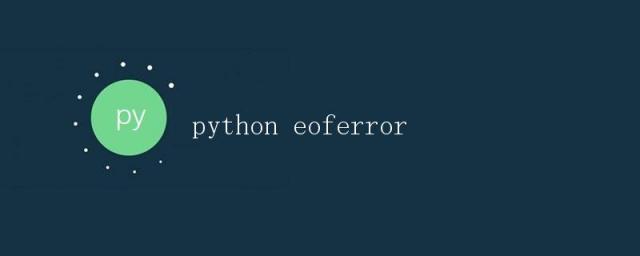Python EOFError异常详解
2024年05月20日 Python EOFError异常详解 极客笔记
Python EOFError异常详解

在Python中,EOFError是指当作为一个文件结束条件或者标志检测到文件结束时引发的异常。EOFError在Python中通常用于处理文件操作或者输入操作中可能发生的文件读取到末尾的情况。
EOFError异常的产生
EOFError异常通常在以下情况下产生:
- 在读取文件时,当读取到文件末尾时,继续尝试读取文件内容时会引发EOFError异常。
- 在进行输入操作时,当输入结束后再尝试继续输入内容时可能会引发EOFError异常。
下面通过示例代码演示EOFError异常的产生:
# 读取文件内容,并在文件末尾尝试继续读取内容
with open("example.txt", "r") as file:
content = file.read()
print(content)
# 尝试继续读取内容
try:
next_content = file.read()
print(next_content)
except EOFError as e:
print(f"Error: {e}")
运行以上代码,将会输出:
Hello, this is an example file.
Error: EOF when reading a line
EOFError异常的处理
1. 使用try-except语句处理EOFError异常
可以使用try-except语句捕获EOFError异常,并在异常发生时进行相应的处理。下面是一个示例代码:
try:
content = input("请输入内容:")
print(content)
next_content = input("请输入下一个内容:")
print(next_content)
except EOFError as e:
print(f"Error: {e}")
运行以上代码,当在第二次输入内容后按下Ctrl+D(在Windows上按Ctrl+Z)时,将会触发EOFError异常,并输出:
请输入内容:Hello
Hello
请输入下一个内容:Error: EOF when reading a line
2. 使用文件迭代器处理EOFError异常
在文件操作中,可以使用文件迭代器来处理EOFError异常。例如:
with open("example.txt", "r") as file:
for line in file:
print(line, end="")
在这个示例中,使用文件迭代器来逐行读取文件内容,当文件读取到末尾时,自动停止遍历,不会触发EOFError异常。
总结
通过本文的介绍,我们了解了EOFError异常在Python中的特点和常见产生情况。
本文链接:http://so.lmcjl.com/news/4962/